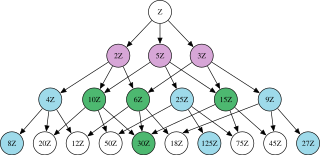In mathematics, an integral domain is a nonzero commutative ring in which the product of any two nonzero elements is nonzero. Integral domains are generalizations of the ring of integers and provide a natural setting for studying divisibility. In an integral domain, every nonzero element a has the cancellation property, that is, if a ≠ 0, an equality ab = ac implies b = c.

In algebra, a prime ideal is a subset of a ring that shares many important properties of a prime number in the ring of integers. The prime ideals for the integers are the sets that contain all the multiples of a given prime number, together with the zero ideal.
In mathematics, a principal ideal domain, or PID, is an integral domain in which every ideal is principal. Some authors such as Bourbaki refer to PIDs as principal rings.
In mathematics, rings are algebraic structures that generalize fields: multiplication need not be commutative and multiplicative inverses need not exist. Informally, a ring is a set equipped with two binary operations satisfying properties analogous to those of addition and multiplication of integers. Ring elements may be numbers such as integers or complex numbers, but they may also be non-numerical objects such as polynomials, square matrices, functions, and power series.
In commutative algebra, the Krull dimension of a commutative ring R, named after Wolfgang Krull, is the supremum of the lengths of all chains of prime ideals. The Krull dimension need not be finite even for a Noetherian ring. More generally the Krull dimension can be defined for modules over possibly non-commutative rings as the deviation of the poset of submodules.
In mathematics, a Noetherian ring is a ring that satisfies the ascending chain condition on left and right ideals; if the chain condition is satisfied only for left ideals or for right ideals, then the ring is said left-Noetherian or right-Noetherian respectively. That is, every increasing sequence of left ideals has a largest element; that is, there exists an n such that:
In mathematics, a commutative ring is a ring in which the multiplication operation is commutative. The study of commutative rings is called commutative algebra. Complementarily, noncommutative algebra is the study of ring properties that are not specific to commutative rings. This distinction results from the high number of fundamental properties of commutative rings that do not extend to noncommutative rings.
In abstract algebra, a Dedekind domain or Dedekind ring, named after Richard Dedekind, is an integral domain in which every nonzero proper ideal factors into a product of prime ideals. It can be shown that such a factorization is then necessarily unique up to the order of the factors. There are at least three other characterizations of Dedekind domains that are sometimes taken as the definition: see below.
Ring theory is the branch of mathematics in which rings are studied: that is, structures supporting both an addition and a multiplication operation. This is a glossary of some terms of the subject.
In mathematics, a finitely generated module is a module that has a finite generating set. A finitely generated module over a ring R may also be called a finite R-module, finite over R, or a module of finite type.
In ring theory, a branch of mathematics, a ring is called a reduced ring if it has no non-zero nilpotent elements. Equivalently, a ring is reduced if it has no non-zero elements with square zero, that is, x2 = 0 implies x = 0. A commutative algebra over a commutative ring is called a reduced algebra if its underlying ring is reduced.
In abstract algebra, a discrete valuation ring (DVR) is a principal ideal domain (PID) with exactly one non-zero maximal ideal.
In abstract algebra, a valuation ring is an integral domain D such that for every non-zero element x of its field of fractions F, at least one of x or x−1 belongs to D.
In mathematics, a GCD domain is an integral domain R with the property that any two elements have a greatest common divisor (GCD); i.e., there is a unique minimal principal ideal containing the ideal generated by two given elements. Equivalently, any two elements of R have a least common multiple (LCM).
In mathematics, a Bézout domain is an integral domain in which the sum of two principal ideals is also a principal ideal. This means that Bézout's identity holds for every pair of elements, and that every finitely generated ideal is principal. Bézout domains are a form of Prüfer domain.
In commutative algebra, an element b of a commutative ring B is said to be integral over a subring A of B if b is a root of some monic polynomial over A.
In mathematics, a Prüfer domain is a type of commutative ring that generalizes Dedekind domains in a non-Noetherian context. These rings possess the nice ideal and module theoretic properties of Dedekind domains, but usually only for finitely generated modules. Prüfer domains are named after the German mathematician Heinz Prüfer.
In commutative algebra, an integrally closed domainA is an integral domain whose integral closure in its field of fractions is A itself. Spelled out, this means that if x is an element of the field of fractions of A that is a root of a monic polynomial with coefficients in A, then x is itself an element of A. Many well-studied domains are integrally closed, as shown by the following chain of class inclusions:
This is a glossary of commutative algebra.







































